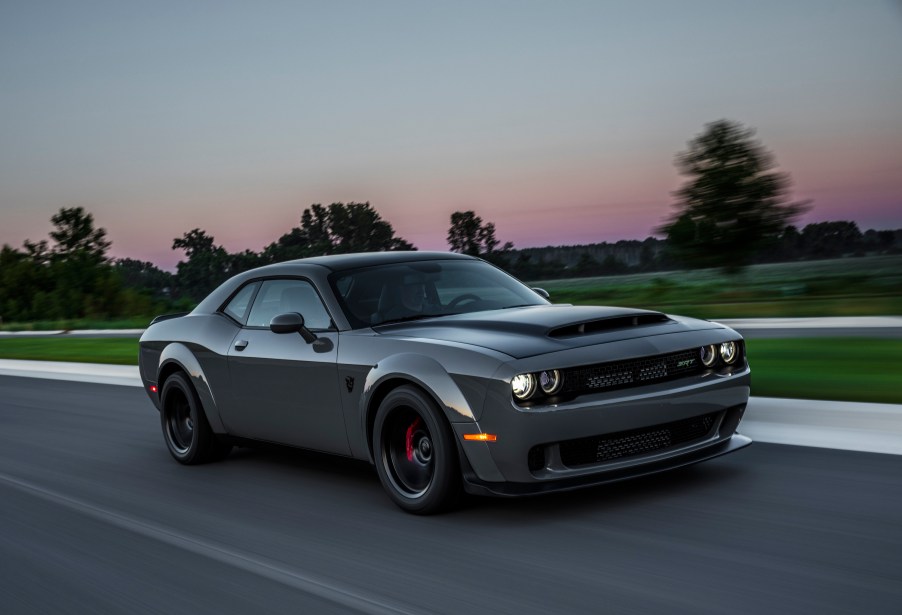
There Definitely Won’t Be Another Dodge Demon
It’s official: Dodge will not produce any more Dodge Demons, FCA head of passenger cars Tim Kuniskis told Muscle Cars and Trucks. Despite overwhelming popularity, the powerful Challenger SRT Demon is destined to remain a collector’s item.
A REAL POWERHOUSE
The Dodge Challenger SRT Demon is a truly impressive car. Boasting 840 hp, the Demon not only surpasses the horsepower rating of every other Challenger, but of every other production V8. It goes from 0 to 60 mph in 2.3 seconds, and its quarter-mile speed is 9.65 seconds at 140 mph, making it the fastest production car in the world, as certified by the NHRA.
In fact, the Demon is such a powerful car that it was banned from racing at NHRA events—technically, at least. NHRA races require a full roll cage in any vehicle that has a nine-second quarter-mile speed, but this wouldn’t necessarily be a problem for everyone who drives a Demon. Kuniskis told Road & Track that while it is certainly possible to reach the 9.65-second quarter-mile speed in a Demon, the average driver would most likely not be able to achieve this right away.
Regardless, its technical ban from NHRA races is not the only thing that sets the Demon apart. In addition to its impressive stats, the Demon is also certified by the Guinness Book of World Records as the first production car that can pop a wheelie. It is worth noting, however, that while the Demon was technically marketed as a production car, it can’t truly compare to most production cars on the market. Its immense power, which puts it at supercar level, comes partially from the fact that it was sold with significant modifications—perhaps most notably, the Demon did not come with a passenger seat unless you specifically requested one.
EXCLUSIVITY AND INTRIGUE
So why exactly is Dodge retiring this car? After all, with the amount of demand the market still has for it, the Demon could easily continue to sell. But this car isn’t being shelved because it’s not doing well—in fact, the complete opposite.
When the Demon was first released, Dodge announced that it would limit production to 3,300, with only 3,000 cars available in the U.S. market and the other 300 slated for release in Canada. In a letter to auto dealers prior to the car’s release, Dodge stated, “Not everyone who wants a Demon will be able to buy a Demon.”
This exclusivity has surrounded the Demon from the very beginning, and the goal, according to Dodge, was simple: to raise enough interest in the car that even people who didn’t consider themselves car enthusiasts would want to know more. If these people decided to do more research into the Demon, Dodge reasoned, they would discover a whole range of exemplary cars and become invested in the franchise as a whole, rather than just one singular vehicle.
It is also worth noting that Dodge anticipated the fact that the exclusivity of the Demon could drive prices through the roof, and it tried to partially prevent this. In its letter to auto dealers, Dodge warned against allowing the car to become seen as something that only the elite could afford. Instead, it encouraged dealers to showcase the Demon as a “halo” for Dodge and the dealership. Ultimately, the Demon was never explicitly meant to be a symbol of class, but of the quality of Dodge’s cars.
Because it was marketed as a serialized car, there is no hope of Dodge producing more Demons. Enthusiasts who didn’t get a chance to purchase one while they were in production will have to search for a secondhand option.
If the Demon was exclusive before, however, it’s even more exclusive now. According to Muscle Cars and Trucks, secondhand Demons available online are selling for around $100,000, with some going for as much as $130,000. This is a significant price jump from its original value of around $85,000, truly marking the beginning of the Dodge Demon’s life as a collector’s item.


